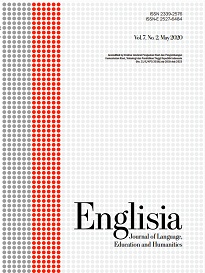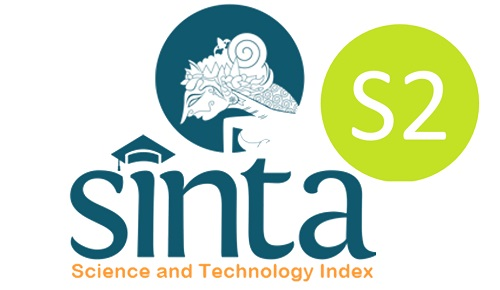The analysis of the use of satire in the daily show with Trevor Noah
DOI:
https://doi.org/10.22373/ej.v10i2.16611Keywords:
Satire, Daily show with Trevor Noah, Tv show.Abstract
Various TV channels established with various talk shows stand out among other shows for presenting bitter facts in a very light-hearted way by commenting, satirizing, analyzing and criticizing in a very funny style. "The Daily Show with Trevor Noah" is a very popular comedy talk show in the United States because of its high language, witty praise, and especially the characters of "The Daily Show with Trevor Noah" criticizing various aspects of society. The aims of this study are to categorize various types of satire and reveal Trevor Noah's technique in expressing satire. This study uses a qualitative descriptive design with a sample of six episodes of The Daily Show with Trevor Noah downloaded from the official comedy center website. The data concentrated on the Satire utterances of the host of The Daily Show with Trevor Noah were analyzed using interactive analysis. The results of the analysis showed that three types of satire appeared in the event: 21 Horatian satires, 13 juvenile satires, and 16 Menippean satires. The satire that is used in the daily show has conveyed a message of criticism of someone's ideas and behavior based on what they have said and done based on events that actually happened. Sacrificial conclusions have become the most powerful and effective way of getting a message across, even today, no matter what means a satirist chooses to create their work.
Downloads
References
Abrams, M. H., & Harpham, G. G. (2015). A Glossary of Literary Terms (11th ed.). Wadsworth Cengage Learning.
Akingbe, N. (2014). Speaking denunciation: satire as confrontation language in contemporary Nigerian poetry. Afrika Focus, 27(1). https://doi.org/10.21825/af.v27i1.4896
Becker, A. B., & Bode, L. (2018). Satire as a source for learning? The differential impact of news versus satire exposure on net neutrality knowledge gain. Information, Communication & Society, 21(4), 612–625. https://doi.org/10.1080/1369118X.2017.1301517
Brownstein, B. (2017, July 29). Trevor Noah delivers the satirical goods – always with a smile. Montreal Gazette.
Burgers, C., & Brugman, B. C. (2022). How Satirical News Impacts Affective Responses, Learning, and Persuasion: A Three-Level Random-Effects Meta-Analysis. Communication Research, 49(7), 966–993. https://doi.org/10.1177/00936502211032100
Chen, H.-T., Gan, C., & Sun, P. (2017). How Does Political Satire Influence Political Participation? Examining the Role of Counter- and Proattitudinal Exposure, Anger, and Personal Issue Importance . International Journal of Communication, 11, 3011–3029.
Čomić. (2019). Why satirical news sites matter for society. What’s New in Publishing.
Condren, C. (2012). Satire and definition. Humor, 25(4). https://doi.org/10.1515/humor-2012-0019
Declercq, D. (2018). A Definition of Satire (And Why a Definition Matters). The Journal of Aesthetics and Art Criticism, 76(3), 319–330. https://doi.org/10.1111/jaac.12563
Elliot, R. C. (2022). Satire. Encyclopedia Britannica. In Britannica.
Gift, N. O. (2019). A Stylistic Reading of the Satirical Import in Selected Punch Newspaper Political Cartoons. Research on Humanities and Social Sciences, 9(14), 23–31. https://doi.org/10.7176/RHSS
Groel, C. (2020). The Daily Show with Trevor Noah: A Thoughtful Blend of News and Entertainment.
Hoffman, L. H., & Young, D. G. (2011). Satire, Punch Lines, and the Nightly News: Untangling Media Effects on Political Participation. Communication Research Reports, 28(2), 159–168. https://doi.org/10.1080/08824096.2011.565278
Holeman, C. T. (2017). Succès de Scandale: the Role of Satire in French Society. University of Mississippi.
Jones, M. O. (2017). Satire, social media and revolutionary cultural production in the Bahrain uprising: From utopian fiction to political satire. Communication and the Public, 2(2), 136–153. https://doi.org/10.1177/2057047317706372
Leymann, S., Lentz, T. O., & Burgers, C. (2022). Prosodic markers of satirical imitation. HUMOR, 35(4), 509–529. https://doi.org/10.1515/humor-2021-0138
Miles, M. B., Huberman, A. M., & Saldana, J. (2014). Qualitative Data Analysis, A. Methods Sourcebook (3rd ed.). Sage Publications.
Murodova, M. I. (2022). Satire: its nature and methods. Science and
Education, 3(1), 735–741.
Newman, M. C. (2010). The Daily Show and Meta-Coverage: How Mock News Covers the Political Communications System. The Elon Journal of Undergraduate Research in Communications, 1(2), 5–16.
Nugraha, D. S. (2022). On Silent Laughter: The Political Humour Depicted in Indonesian Cartoons. VELES Voices of English Language Education Society, 6(1), 283–298. https://doi.org/10.29408/veles.v6i1.5022
Peifer, J., & Lee, T. (2019). Satire and Journalism. In Oxford Research Encyclopedia of Communication. Oxford University Press. https://doi.org/10.1093/acrefore/9780190228613.013.871
Peifer, J. T. (2018). Imitation as Flattery: How TV News Parody’s Media Criticism Can Influence Perceived News Media Importance and Media Trust. Journalism & Mass Communication Quarterly, 95(3), 734–756. https://doi.org/10.1177/1077699017713002
Phiddian, R. (2013). Satire and the limits of literary theories. Critical Quarterly, 55(3), 44–58. https://doi.org/10.1111/criq.12057
Salsabila, B. V., & Simatupang, E. C. (2021). Satir on the political meme of President Donald Trump: a semantic. English Journal Literacy UTama, 5(2), 6.
Tandoc, E. C., Lim, Z. W., & Ling, R. (2018). Defining “Fake News.” Digital Journalism, 6(2), 137–153. https://doi.org/10.1080/21670811.2017.1360143
Young, D. G. (2013). Laughter, Learning, or Enlightenment? Viewing and Avoidance Motivations Behind The Daily Show and The Colbert Report. Journal of Broadcasting & Electronic Media, 57(2), 153–169. https://doi.org/10.1080/08838151.2013.787080
Downloads
Published
Issue
Section
License
Proposed Policy for Journals That Offer Open Access
Authors who publish with Englisia journal agree to the following terms:
- Authors retain copyright and grant the journal right of first publication with the work simultaneously licensed under a Creative Commons Attribution License that allows others to share the work with an acknowledgement of the work's authorship and initial publication in this journal.
- Authors are able to enter into separate, additional contractual arrangements for the non-exclusive distribution of the journal's published version of the work (e.g., post it to an institutional repository or publish it in a book), with an acknowledgement of its initial publication in this journal.
- Authors are permitted and encouraged to post their work online (e.g., in institutional repositories or on their website) prior to and during the submission process, as it can lead to productive exchanges, as well as earlier and greater citation of published work (See The Effect of Open Access).









